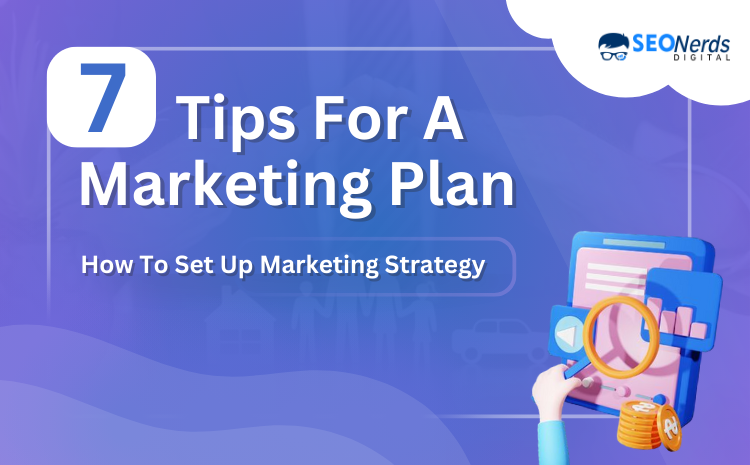How To Set Up Marketing Strategy – 7 Tips For A Marketing Plan

7 Tips To Ensure the Right Marketing Approach
A successful business thrives on a well-crafted marketing plan and strategy that hits its goals and targets its audience smartly. It’s not just about creative ideas but understanding the market, outsmarting competitors, understanding customer desires, and how to set up marketing strategy. This marketing strategy helps lay out the tricks and channels to engage and win over your audience.
Here is a break down the essential parts of a stellar marketing plan and give you a step-by-step approach to align with your marketing goals. The article will also help you dig deeper into various marketing components and proven ways to keep your strategy sharp and effective.
So let’s uncover the secrets to crafting a winning marketing plan for your business. With the right approach, you can ensure your marketing efforts are always on point and driving success.
Why Is A Marketing Strategy Important?

Without a clear strategy, you will be just experimenting with random tactics, wasting money, time, and resources. But with a solid marketing strategy, you can efficiently reach your target audience and turn first-time visitors into loyal customers. Here is why a well-planned strategy for marketing is crucial –
- Offers Direction -A marketing plan sets clear goals and maps out the steps to achieve them. It integrates all marketing efforts within your organization for maximum impact.
- Targets the Right Audience – A well-defined strategy helps pinpoint and understand your target audience. This allows you to tailor your messaging and reach the right people at the right time.
- Builds Brand Identity – Strategizing ensures a consistent and cohesive brand identity. It aligns all marketing activities, boosting brand recognition and fostering customer loyalty.
- Maximizes ROI – By analyzing market trends, competitors, and customer behavior, a strategy identifies the best channels and tactics for investment, ensuring you get the highest return on your investment.
- Evaluates Performance – A strategy outlines key metrics and performance indicators, making it easier to measure and track the success of your marketing efforts. This provides insights for data-driven decisions and helps refine future campaigns for better outcomes.
Marketing Strategy Components

A strong plan and strategy for marketing is built on several key components that drive success. Creating a detailed marketing plan and understanding these elements is crucial for learning how to set up marketing strategy. This ensures a well-rounded approach to achieving your goals. Here are the key components to consider when developing strategy for your specific marketing goals-
1. Marketing Mix
Known as the 4 Ps, the marketing mix provides a blueprint for understanding essential aspects of your marketing efforts. The four ps of marketing includes:
- Product or service: Define the features, benefits, and unique qualities of your offerings, and understand its value proposition.
- Price: Determine the appropriate pricing strategy based on production costs, market demand, competitor pricing, and perceived value.
- Place: Identify optimal distribution channels and locations where your product or service will be available to customers.
- Promotion: Develop a comprehensive plan to promote your product or service, including suitable marketing channels and persuasive messages.
Understanding the marketing mix is crucial for learning how to set up marketing strategy efficiently.
Did You Know?
Marketers who base their campaigns on their strategy are 356% more likely to achieve success.
2. Objective of Marketing
Setting clear marketing goals within the marketing plan framework is crucial for a robust strategy. Well-defined objectives ensure proper budget allocation and steer content creation effectively. Use the SMART criteria to create actionable goals-
- Specific: Clearly outline what you aim to achieve.
- Attainable: Ensure goals are realistic within your resources.
- Measurable: Set concrete metrics to monitor progress.
- Time-bound: Establish a clear timeline for goal completion.
- Relevant: Align objectives with broader business targets.
Regular evaluation and adjustment of these goals are essential to stay agile in a dynamic market environment. Know that mastering how to set up marketing strategy involves this rigorous goal-setting process.
3. Budget For Marketing
A meticulously crafted marketing budget is crucial. Allocate resources for top-tier talent, cutting-edge software, strategic advertising, compelling content creation, and ROI-driven channels to maximize impact. This is another important component in achieving the desired progress of your marketing plan. Understanding how to set up marketing strategy will help you ensure proper financial planning to ensure optimal results.
4. Analysis of Market Competition
Conducting a thorough competitor analysis is essential for standing out in the market. Ensure deep market research and analyze the landscape to conduct a solid SWOT analysis. This process will give you sustainable competitive advantage and help you understand your ideal customer. Use these insights to fine-tune your marketing tools and shape your how to set up marketing strategy, ensuring you outpace your competitors.
5. Segmentation For Creating Buyer Personas
Effective segmentation and targeting are crucial for creating tailored messages. Define your persona and focus on specific market segments. Craft a marketing message that underscores your unique value proposition and resonates with your ideal customer. This approach will sharpen your marketing plan and help you understand how to set up marketing strategy for the best results.
6. Content Creation
Drive your content strategy by leveraging emerging trends and using diverse formats like videos, images, blog posts, info-graphics, and podcasts. Tailor your approach to your target segment to ensure content is consistent and cohesive with your marketing goals. Learn how to set up marketing strategy with compelling content that boosts your sales.
Related – 10 Tips for Creating a Successful Business Blog
7. Key Performance Indicators And Metrics
Use metrics and KPIs to measure the success of your marketing plan. Examples of KPIs include Organic Traffic, Customer Acquisition Cost, Marketing Qualified Leads and Conversion Rate. These tools help you evaluate the success of your strategy and are essential for monitoring and evaluation. Knowing how to set up marketing strategy also means tracking measurable results to guarantee a business’s success.
Tips For Creating a Marketing Strategy Outlines in 2024

Crafting a successful marketing strategy in 2024 begins with a clear outline. Apply the following tips for the best marketing results and to effectively reach your target audience. So keep reading how to set up marketing strategy to drive your success.
1. Conduct Market Research
Creating a winning marketing plan and strategy starts with truly knowing your market and audience. This involves more than just a cursory look. It requires the following –
Know Your Audience
First, you need to build a strong marketing roadmap by understanding who your customers are and what they want. This means exploring their age, gender, income, and where they live. Here’s how you can do it –
- Surveys and focus groups – They are ideal for collecting detailed information about your audience.
- Website and social media analytics – It helps you to find out which content resonates with people.
- Industry reports – They give you a broader view of consumer trends and competitive insights.
Segmenting your research into the categories helps in refining your approach –
- Age-based research – It reveals which age groups are interested in your products, helping tailor your marketing messages.
- Gender-based research – It shows which products are popular among different genders, guiding targeted campaigns.
- Income-based research – It helps in identifying spending power, which is crucial for positioning luxury or budget-friendly products.
- Geographical research – It helps in determining the high-demand areas, guiding where to focus your marketing endeavors or open new locations.
Understand Customer Behavior
Next, you need to study how your customers interact with your brand. This involves –
- Analyzing purchase history – To see what products are popular and adjusting your promotions accordingly.
- Using website analytics – To track how visitors engage with your site, tweaking content or design to keep them interested.
- Listening to social media – To understand what customers are saying about you, addressing their questions and concerns to build stronger relationships.
Incorporating research and customer feedback into your strategy is essential. It helps in crafting targeted marketing initiatives that align with your audience’s needs. Ultimately, this detailed approach on how to set up marketing strategy ensures that your efforts are well-informed and impactful.
Fact
Feedback is crucial because, according to a study, 96% of dissatisfied customers never share their complaints with the company.
2. Define Your Goals
Setting clear goals is essential whether you’re looking to increase brand awareness, boost sales, enhance customer engagement, or break into a new market. Using SMART goals – Specific, Measurable, Attainable, Relevant, and Time-bound can help you track the progress of your marketing planning.
SMART goals make your objectives clear and actionable. They help you visualize what you want to achieve, assign tasks to the right team members, and stay focused and motivated. This approach also helps you spot any unrealistic targets, like aiming for too many email signups in a short time, and adjust them before they become a problem.
A well-defined plan outlines specific goals that act as a roadmap for your marketing efforts. It ensures you understand your target audience and how your product and service meets their needs. This alignment supports your overall business strategy and drives growth.
By using SMART goals, your plan may become a powerful tool that helps you understand how to set up marketing strategy, ensuring your efforts lead to real, measurable success.
3. Understand the Target Audience and Market
Create a clear profile of your average customer, focusing on their needs and problems. Identify their age, location, family size, job, lifestyle, and spending habits. Describe a typical day in their life to understand their behavior and preferences. Consider where they spend money, like gyms, theaters, and grocery stores, to tailor your marketing tactics.
A strong marketing plan requires a deep understanding of the target audience. Conduct thorough market research to find out where your customers are likely to purchase. This insight helps in knowing how to set up marketing strategy that truly connects with your audience and drives success.
Also read – Ways To Drive Traffic To Your Website: 3O Proven Ways
4. Conduct Competitive Analysis
In a market flooded with options, carving out a unique position is crucial for achieving sustainable competitive advantage. A meticulous competitive analysis is important to refine your marketing plan. Start by profiling key competitors. Engage with sources of valuable insights, such as sales teams and business partners. Evaluate their digital footprint, including linkedin profiles, websites and social media platforms, to analyze their online presence.
Collect details of their readily accessible marketing materials and pricing lists. Sift through online reviews and ratings to understand customer sentiment. Consider purchasing their products or services to experience their offerings firsthand. This approach provides a comprehensive view of their market share and operational strategies.
Gather detailed information on competitors’ products and services, pricing models, customer service standards, supply chains, and brand differentiators. This intel helps you discern what sets your business apart. Your objective is to determine how you can meet current and future customer needs more effectively than your competitors.
A thorough competitive analysis requires a deep understanding of how competitors operate and where you fit in. Use these insights to build a strong strategy that drives business growth. By assessing how businesses make and sustain their market presence, you’ll be able to enhance your approach and carve out a distinctive position in the market.
Related – 5 High-Impact Digital Marketing Strategies to Promote Your Shopify Store
5. Choose the Right Channels for Marketing
Promoting your product or service requires selecting the right channels that resonate with your target audience and align with your goals. With numerous options available, finding your ideal marketing channel can be daunting. To navigate this, start with a clear understanding of your audience. Identify where they spend time online, be it social media channels like Instagram or Facebook, or reading industry publications. This insight is crucial for effective targeting.
Next, align your marketing objectives with the channels. If your goal is to boost brand awareness, social media channels or influencer marketing might be your best bet. On the other hand, if driving conversions and sales is your priority, email marketing or paid search advertising can be more effective. Your marketing plan should reflect these choices to ensure coherence and focus. These channels are used to create targeted and impactful campaigns.
Budget and resources are also key considerations. Some channels require higher investment and specialized skills. Choose those that are both impactful and feasible within your constraints. Overextending by using too many channels can scatter your message and waste resources. Instead, focus on the most effective ones for your target audience and objectives.
Selecting the right channels ensures you reach a wider audience effectively, optimizing your ad campaign. By doing so, you can implement successful marketing strategies that maximize your efforts and outcomes. This approach is crucial for understanding how to develop a marketing strategy that delivers both success and efficiency.
Did you know?
93% of brands say they gained new customers from videos they’ve shared on social media.
6. Track and Analyze Key Performance Indicators
A strong marketing strategy requires ongoing effort. It’s not a one-time task. You need to monitor and evaluate your progress to see how well your strategy is working. This involves measuring how successful your marketing efforts are compared to the goals you set when you set your marketing campaign.
Use KPIs to track your success. KPIs are specific metrics like social media engagement, website traffic, return on investment, conversion rates, and customer retention. These figures help you see what’s working and what isn’t. For example, if a particular social media platform isn’t performing as expected, you might need to shift your focus to a more effective channel.
Beyond just tracking KPIs, it’s important to analyze the data to gain insights. Conduct customer surveys and market research to understand your audience better. This way, you can measure the results accurately and make informed adjustments to your strategy. Knowing how to set up marketing strategy effectively through these insights will help you achieve your marketing goals.
Related – How AI Will Revolutionize The Future Of SEO
7. Launch Your Marketing Campaign
To run a high-impact marketing campaign, set clear deadlines and expectations for everyone involved. Plan regular check-ins – weekly, monthly, or quarterly to keep things on track. Assign specific goals to team leaders, who can then manage the details and delegate tasks to their team members. This keeps everything organized and ensures everyone knows their role.
When it’s time to assess how well your strategies are working and make any necessary adjustments, meet with the team leaders instead of the entire team. This focused approach makes it easier to review progress and make changes quickly.
Make sure your plan is aligned with your business goals and focuses on how to increase brand awareness. By setting clear targets and reviewing them regularly, you can adjust your strategy to achieve the results you want. This is key to understanding how to set up marketing strategy that delivers real impact. A well-defined strategy might be crucial for refining your approach and driving success.
How to Set Up Marketing Strategy – Steps to Take After Implementing Your Marketing Plan

- Keep a check on your resources – Ensure successful marketing by confirming you have all the necessary resources and expertise. Evaluate whether you’ve allocated the right budget, if your team has the required knowledge and skills, and if you need to up-skill existing staff or hire new talent. Consider engaging an external marketing partner if there are gaps.
- Focus on training and development – Sign up for personalized training based on your business needs and how to set up marketing strategy. For instance, online businesses may need to focus on website and social media management.
- Promote communication and collaboration – Make sure your team understands how marketing integrates with your business goals. Involve them throughout the strategy and planning process, mentor those passionate about marketing, and keep communication open. This approach will help you achieve your marketing goals and enhance your value proposition.
Also Read – A Comprehensive Guide to Local SEO in 2024
Conclusion – How to Set Up Marketing Strategy

In the fast-changing marketing world, a business needs a strong strategy based on a deep understanding of its target audience and market. It’s time to create a strategy that contains the company’s core objectives, provides a clear messaging framework, and uses a focused content approach across the best marketing channels. This plan should also include measurable goals and be adaptable to the shifting landscape of market and customer demands. Regular reviews and updates are crucial for ensuring the strategy remains relevant and effective. Ultimately, a winning marketing strategy is a dynamic blueprint designed to increase sales and requires ongoing monitoring and adjustment.











Write a Comment